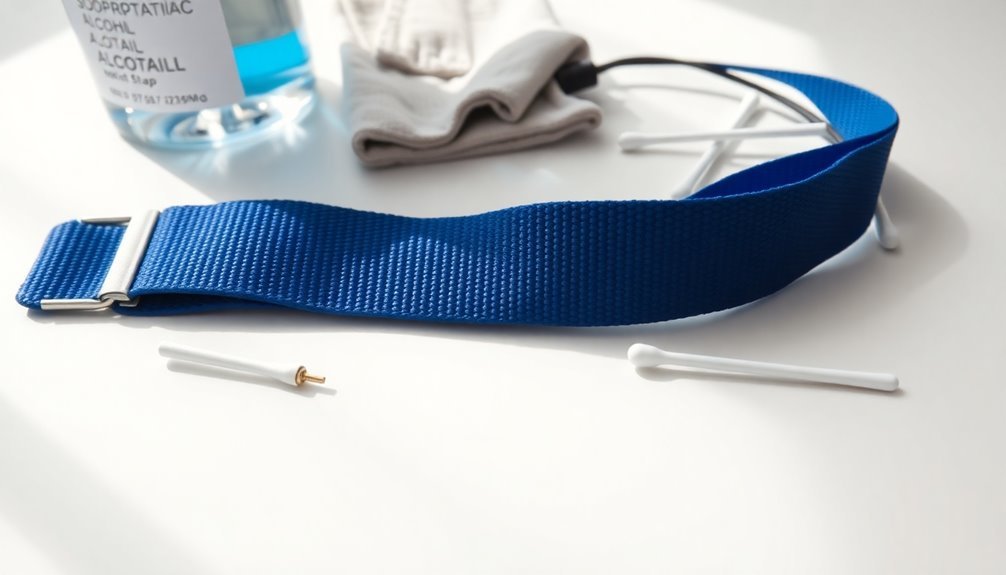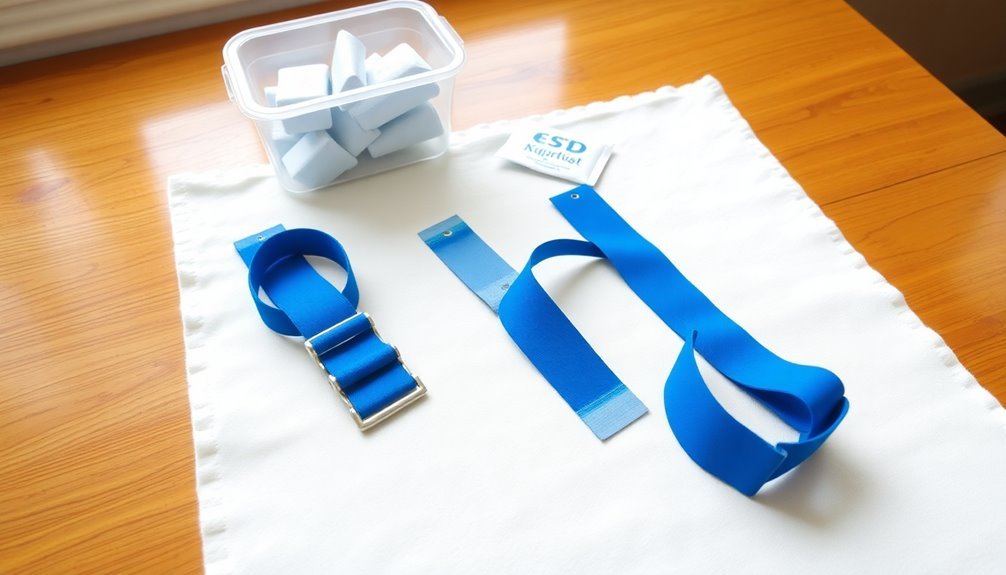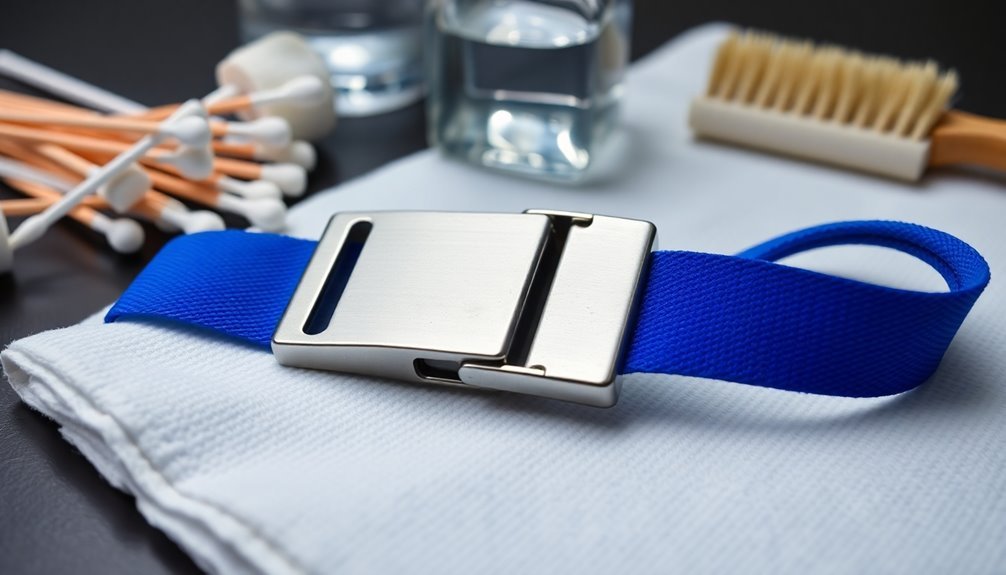Clean your ESD strap with a mild, non-ionic detergent like Woolite, avoiding harsh chemicals, alcohol, or bleach that can damage the silver fibers. For elastic wristbands, machine wash on cold or warm settings, while metallic expansion bands need gentle hand washing with a soft microfiber cloth. Always dry on low heat or hang dry indoors, away from direct sunlight. After cleaning, test the strap's electrical resistance and skin contact to verify it's still providing proper protection. Store in a clean, dry place between 15-30°C with moderate humidity. There's much more to maintaining your ESD strap's effectiveness for long-term use.
Understanding ESD Strap Basics

When you're working with electronics, you'll need to connect your strap to a proper grounding point, such as a designated earth bonding point or grounded equipment.
Don't make the mistake of connecting it solely to an anti-static mat – you need a reliable ground connection.
The strap works by keeping you at the same electrical potential as the components you're handling, effectively preventing static discharge events that could harm sensitive circuits.
Regular inspection for wear is crucial to maintain the strap's protective capabilities.
Combined with other ESD protection equipment, your strap forms an essential part of a thorough static control system.
The built-in resistor in each strap provides critical safety by preventing potential electric shocks while maintaining proper grounding function.
Recommended Cleaning Products
To maintain your ESD strap's protective capabilities, you'll need the right cleaning products. The best options are mild, non-ionic detergents like Woolite that won't compromise the strap's static-dissipative properties. Regular cleaning schedules help prevent dirt accumulation that can alter surface resistance. The use of Reztore Surface Cleaner is highly recommended for optimal results. You'll want to avoid harsh chemicals, alcohol-based cleaners, and bleach as these can damage the silver fibers and reduce ESD effectiveness.
| Product Type | Recommendation |
|---|---|
| Detergents | Mild, non-ionic (like Woolite) |
| Surface Cleaners | Specialized ESD solutions |
| Prohibited Items | Alcohol, bleach, harsh solvents |
| Fabric Softeners | Non-ionic types only |
| Cleaning Tools | Microfiber or lint-free cloths |
When selecting your cleaning products, make sure they're free from alkali, ammonia, and any chemicals listed on RoHS and REACH SvHC lists. You'll find specialized ESD cleaning solutions in the market that are specifically designed for maintaining static control properties. Remember to check that your chosen products don't leave residue or films that could interfere with the strap's performance. Always test your ESD strap after cleaning to verify it maintains proper electrical resistance and skin contact.
Step-By-Step Cleaning Process

To properly clean your ESD strap, you'll need mild detergents, soft microfiber cloths, and lukewarm water ready before starting.
Using non-ionic liquid detergents will help maintain the electrical properties of your ESD strap during cleaning.
After cleaning, you'll want to either tumble dry on low heat or hang dry your wristband completely before storing it in a clean, dry place for future use.
Prepare Cleaning Materials First
Proper preparation of cleaning materials guarantees a thorough and safe cleaning process for your ESD straps. You'll need to select mild, multi-purpose neutral cleaners that won't damage the sensitive components of your ESD equipment.
Choose your cleaning tools carefully, focusing on non-abrasive options like microfiber cloths. ESD-specific cleaning solutions are your best bet for maintaining the proper ESD properties of your equipment.
Keep these materials easily accessible and always follow the manufacturer's instructions for use.
- Select non-ionic softeners and detergents, such as Woolite, for gentle but effective cleaning of fabric components
- Use liquid detergents instead of powder-based ones to prevent caking and reduce frictional wear
- Avoid harsh chemicals like bleach or alcohol-based solutions that can damage your ESD equipment
Remember to store your cleaning supplies in a designated area where they're protected from contamination and ready for use.
You'll want to ascertain all materials are properly labeled and maintained according to workplace safety standards.
Washing Your ESD Strap
Cleaning your ESD strap effectively requires a methodical approach to preserve its static-dissipative properties. Start by preparing lukewarm water and adding a mild, non-ionic detergent that won't strip the strap of its positive ions.
If you're cleaning an elastic wristband, you can machine wash it using cold or warm water settings. Don't use bleach or expose it to high heat, as these can damage the ESD properties.
For metallic expansion wristbands, hand wash them gently using a soft microfiber cloth to avoid scratching the surface.
When washing, avoid using abrasive tools or sharp objects that could compromise the strap's integrity. Gently clean all surfaces, paying special attention to areas that make contact with your skin.
If you need to remove stubborn residue, you can use isopropyl alcohol sparingly, but don't make this a regular practice.
After cleaning, thoroughly dry the strap, especially if it's a metallic expansion type, to prevent corrosion. For elastic straps, either tumble dry on low heat or hang them to air dry.
Once dried, test the strap's electrical resistance to verify it's still functioning properly before use.
Drying and Storage Tips
Following a thorough cleaning, the drying and storage process becomes essential for maintaining your ESD strap's effectiveness.
You'll want to dry your strap using the lowest heat setting if machine drying, though hanging it to dry indoors is your best option. Keep it away from direct sunlight during the drying process to prevent material degradation.
Don't iron your ESD strap, as excessive heat can compromise its ESD-safe properties.
Once completely dry, proper storage will extend your strap's lifespan. Choose a cool, dry location away from direct sunlight and moisture to prevent corrosion of the conductive components.
Before storing, verify your strap is thoroughly clean and dry to avoid contamination.
For ideal maintenance during storage and handling:
- Inspect your strap regularly for signs of wear or damage
- Store it in a designated area to prevent loss or accidental damage
- Handle the conductive components gently, avoiding unnecessary bending or folding
Remember to maintain proper documentation of your strap's testing and compliance verification.
This systematic approach to drying and storage will help preserve your ESD strap's effectiveness and guarantee reliable static protection when you need it.
Safety During Cleaning
Remember to keep your cleaning supplies separate from general-purpose items, and never share ESD straps between operators.
You should always connect your wrist straps to a proper groundable point, not to the edge of a dissipative mat.
After cleaning, conduct regular inspections of your ESD equipment and replace any items that show signs of wear or have exceeded their useful life cycle.
Common Cleaning Mistakes

When cleaning your ESD straps, you'll want to avoid harsh chemical solutions like bleach or Dettol that can damage the electrostatic properties.
Don't dry your ESD straps using high heat or direct sunlight, as these can compromise the material's static-dissipative qualities.
You'll also need to pay special attention to the metal components, ensuring they're properly cleaned and tested for conductivity after maintenance.
Using Harsh Chemical Solutions
The use of harsh chemical solutions represents one of the most damaging mistakes in ESD strap maintenance. When you're cleaning your ESD straps, it's vital to avoid alcohol-based solutions, including isopropyl alcohol (IPA) and Dettol wipes, as they can severely degrade the material's protective properties.
General anti-bacterial products and harsh chemicals containing solvents, alkali, or ammonia can also compromise your ESD equipment's effectiveness.
Instead of using these harmful substances, you should opt for:
- Mild, neutral cleaners specifically designed for ESD surfaces
- ESD-safe cleaning products like Reztore Surface and Mat Cleaner
- Gentle liquid detergents for launderable components
When cleaning your ESD straps, always use soft microfiber cloths and avoid abrasive tools that could damage the surface.
While non-bleach laundry sanitizers might seem like a safe alternative, they're not recommended for long-term use as they can still affect the material's properties over time.
Remember to test your wrist strap system after cleaning to verify it maintains proper electrical resistance and skin contact. This verification step is essential for maintaining compliance with ESD safety standards.
Improper Drying Methods
Following proper drying procedures can make or break your ESD strap's effectiveness and longevity. You'll want to avoid several common drying mistakes that can permanently damage your equipment.
Never use high heat sources like heat guns, microwaves, or ovens, as these can degrade the ESD materials and compromise their protective properties.
When drying elastic wristband strips, don't rush the process with forced hot air or direct sunlight. Instead, opt for low-heat settings or simply hang them to dry naturally.
For metallic components, you'll need to be especially careful to prevent corrosion and mineral deposits. Pat these parts dry with a soft cloth rather than exposing them to intense heat.
Don't leave your ESD straps in humid environments or attempt to speed up drying with harsh chemicals, as both can seriously impact their effectiveness.
You should store your straps in well-ventilated areas and regularly inspect them for signs of wear.
Remember that over-drying can lead to brittleness in ESD materials, so it's essential to be patient and gentle during the drying process to maintain your strap's protective qualities.
Neglecting Metal Components
Protecting metal components stands as a vital yet often overlooked aspect of ESD strap maintenance. When cleaning your ESD straps, you'll need to pay special attention to the metallic parts, as they're necessary for proper grounding and functionality.
Using harsh chemicals or abrasive materials can severely compromise the effectiveness of these essential components. To properly maintain your ESD strap's metal elements, use only mild detergents and soft, lint-free cloths.
You'll want to avoid common mistakes like using bleach, alcohol-based cleaners, or strong detergents that can degrade the metal surfaces. It's also important to thoroughly dry metallic expansion wristbands to prevent corrosion.
- Use non-ionic softeners and cleaners specifically designed for ESD products
- Clean metal components gently with a soft cloth and avoid brushes or scrubbers
- Test your ESD strap after cleaning to verify proper electrical resistance
Regular inspection and maintenance of metal components will extend your ESD strap's lifespan. If you notice signs of wear or damage, consider replacing the strap rather than risking potential equipment damage.
Remember to store your ESD straps in a clean, dry environment to prevent metal corrosion and maintain peak performance.
Drying Best Practices
Proper drying of your ESD straps is essential for maintaining their effectiveness and longevity. After cleaning, you'll need to verify your straps are completely dry before using them again to prevent corrosion and maintain proper electrical conductivity.
For metallic expansion wristbands, don't rush the drying process by applying heat. Instead, let them air dry naturally in a clean environment. If you must use a dryer, only use the lowest heat setting, though air drying is always preferable to protect the metal components.
When drying elastic wristbands, you've got two safe options: air drying or tumble drying on low heat. High temperatures can damage the elastic material and compromise the ESD protective properties, so avoid using high heat settings on your dryer.
Don't expose your wristbands to direct sunlight, and never use heat guns, blow dryers, or chemical drying agents. Keep your wristbands away from heating elements and verify they're completely dry before use.
Remember to dry them in a clean environment to prevent contamination and static buildup. These precautions will help preserve your ESD straps' protective qualities and extend their service life.
Maintenance After Cleaning

Regular maintenance checks after cleaning your ESD straps will guarantee their continued effectiveness and safety.
You'll need to verify the electrical resistance and skin contact after each cleaning session to confirm they meet technical requirements. It's essential to maintain detailed compliance records that demonstrate conformity to specifications and safety standards.
After cleaning, you should inspect your ESD straps for any signs of wear, corrosion, or damage.
Pay special attention to metallic expansion wristbands, as they're particularly susceptible to corrosion if not dried properly. You'll want to confirm all components remain in good working condition and haven't been compromised by the cleaning process.
- Test the wrist strap system's electrical resistance using appropriate testing equipment
- Check all connection points and confirm they're free from residue or buildup
- Inspect the fabric and metal components for any signs of degradation or wear
Remember that sharing ESD straps isn't recommended, so you should be responsible for maintaining your own equipment.
If you notice any deterioration or if the strap is nearing the end of its life cycle, don't hesitate to replace it.
Always follow the manufacturer's guidelines for maintenance procedures to maintain peak performance.
Signs of Wear
While performing maintenance checks, you'll need to know exactly what to look for when examining your ESD straps for wear and tear. Start with a visual inspection, checking for cracks in the strap material, frayed conductive threads, and any signs of corrosion on metal components.
You'll also want to look for missing or damaged compliance labels and any discoloration that might indicate chemical damage.
Pay close attention to functional issues that could compromise your strap's effectiveness. If you're noticing increased static discharge events or having trouble achieving reliable grounding, your strap may need replacement. The total system resistance shouldn't exceed 35 megohms, and it must pass compliance verification tests according to EN 61340-5-1.
Watch for material deterioration like softening, hardening, or delamination of the strap. Heat damage, particularly above 50°C, can seriously compromise the strap's integrity.
You'll also need to monitor usage-related wear, such as damaged clasps or adjustment mechanisms. If the strap won't maintain proper skin contact or has exceeded the manufacturer's recommended lifespan, it's time for a replacement.
Storage After Cleaning

Once you've cleaned your ESD straps, storing them correctly helps maintain their effectiveness and extend their lifespan. Keep them in a clean, dry environment away from direct sunlight and chemical substances, ideally at temperatures between 15°C and 30°C.
For maximum protection, store your straps in their original packaging or ESD-safe containers that prevent stretching and tangling. Maintain a controlled environment with humidity levels between 35-60% RH, and make sure you're using non-conductive storage materials.
It's crucial to store each strap separately and label your storage containers with proper handling instructions. For convenient access, consider keeping them near your workstation while protecting them from magnetic fields.
For long-term storage success, follow these key practices:
- Inspect stored straps regularly for signs of wear or damage
- Document storage dates and rotate straps every 6-12 months
- Store similar items together, such as ESD smocks and gloves
Remember to follow the manufacturer's guidelines for storage specifications, and regularly assess your stored straps to make sure they remain in peak condition.
This systematic approach to storage will help preserve your ESD straps' functionality and reliability over time.
Regular Care Schedule
Maintaining your stored ESD straps requires a well-planned care schedule. You'll need to regularly clean your wristbands with mild detergent, ensuring you're using liquid cleaners rather than dry ones to prevent caking and wear.
When washing metallic expansion bands, make sure you dry them thoroughly to avoid corrosion.
For your regular cleaning routine, stick to ESD-safe cleaners like Reztore or Staticide that won't compromise the protective properties. While Woolite is acceptable, use isopropyl alcohol sparingly.
If you're washing elastic bands, use cool or warm water and either tumble dry on low heat or hang them to dry. Never use bleach, as it'll damage the ESD properties.
After each cleaning session, you must test your wrist straps for proper electrical resistance and skin contact. Use a wrist strap tester to verify compliance with ESD standards, and keep detailed records of your compliance verification.
If you notice any straps are past their useful life cycle, don't hesitate to replace them. Following these care guidelines will help maintain your ESD straps' effectiveness and extend their service life.
Frequently Asked Questions
Can I Use UV Sanitizers to Clean My ESD Straps?
You shouldn't use UV sanitizers on your ESD straps as they'll degrade the materials and reduce effectiveness. Instead, clean them with mild detergents like Woolite and make certain they're thoroughly dried after cleaning.
How Often Should I Replace the Grounding Cord of My ESD Strap?
You should replace your ESD strap's grounding cord every 6-12 months, depending on usage. If you notice wear, damage, or failed resistance tests, don't wait – replace it immediately to maintain proper protection.
Does Swimming or Excessive Sweating Affect ESD Strap Performance?
Yes, both swimming and excessive sweating can harm your ESD strap's performance. Swimming isn't recommended as it can damage the strap, while sweating reduces efficiency and may cause corrosion. Always keep your strap clean and dry.
Can I Share My ESD Strap With Another Person in Emergencies?
You shouldn't share your ESD strap, even in emergencies. It's against health and safety guidelines, risks cross-contamination, and can compromise performance. Your company should maintain emergency straps for unexpected needs.
Do Different Workplace Environments Require Different Cleaning Frequencies for ESD Straps?
Yes, you'll need to adjust your ESD strap cleaning schedule based on your workplace. Clean daily in high-use areas, monthly in low-use environments, and more frequently in humid or dusty conditions to maintain effectiveness.
In Summary
Maintaining your ESD straps properly will extend their lifespan and guarantee reliable protection. Remember to clean them monthly with mild soap and water, never use harsh chemicals, and always test them after cleaning. Store your straps in a cool, dry place and replace them if you notice any signs of wear or damage. With proper care, you'll keep your equipment safe and your ESD straps functioning effectively.





Leave a Reply